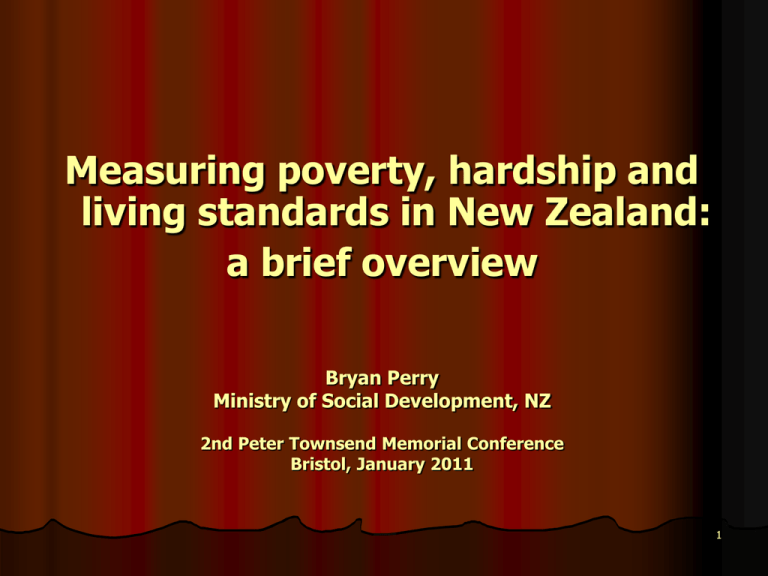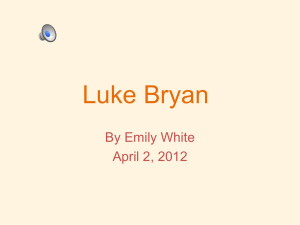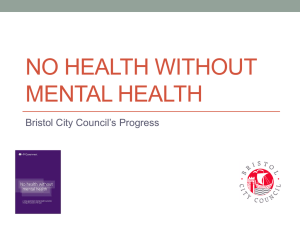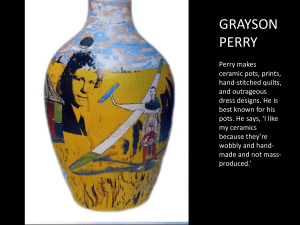
Measuring poverty, hardship and
living standards in New Zealand:
a brief overview
Bryan Perry
Ministry of Social Development, NZ
2nd Peter Townsend Memorial Conference
Bristol, January 2011
1
Introduction
• New Zealand does not have an official measure of
poverty or material hardship …
• the Ministry of Social Development reports on:
– income distribution and income poverty using a range of
measures
– material hardship and deprivation using non-monetary
indicators
• Statistics New Zealand sends NZ income distribution
and income poverty information to the OECD
• involvement by state agencies is relatively recent
– Brian Easton
– NZ Poverty Measurement Project
Bristol
Bryan Perry, Jan 2011
Introduction (cont’d)
• MSD also publishes an annual ‘Social Report’
– includes income distribution and poverty information …
– but it has a wider scope - 10 domains, 43 indicators
• some limited use of ‘social inclusion’ / ‘social
exclusion’ discourse … some on ‘social cohesion’ …
more about ‘social and economic wellbeing’
• some use of an ‘underclass’ notion by current PM
• the major data gap in NZ is for the dynamics of
poverty and hardship … social mobility
Bristol
Bryan Perry, Jan 2011
Outline
• active promotion of a common language and
understanding around poverty and hardship
• using HH incomes
– relative and fixed (anchored) poverty lines
– an illustration of the limitations of the incomes approach
(older NZers)
• using non-monetary indicators to construct more
direct measures of material wellbeing
–
–
–
–
the ELSI measure – its development, properties and value
addressing some of ELSI’s limitations
international comparisons
next steps?
Bristol
Bryan Perry, Jan 2011
Active promotion of the big ideas
• idea of ‘poverty’ in richer nations
– we use the EU’s high level conceptualisation
• income poverty & deprivation – different constructs
• poverty and hardship are multi-dimensional … even
more so if ‘causes’ and ‘consequences’ are included
… but we try to keep an uncluttered focus on the
goods, services and opportunities that money can
buy
• cannot avoid judgment in setting thresholds … but
some thresholds are much more plausible /
defensible than others
Bristol
Bryan Perry, Jan 2011
Income and living standards
Living
standards
HH income
Bristol
Bryan Perry, Jan 2011
Govt services
& subsidies
Current income
(eg last 12 months)
+
Access to
other services
& amenities
+
+
expected future income
Previous
income
+
Assets
Living
standards
+
_
Contributions to budget not
picked up in ‘current income’
eg HH production,
help from outside the HH
Special demands on budget
eg unexpected bill
health/disability costs
high housing costs
support for others o/s HH
Bristol
Bryan Perry, Jan 2011
Govt services
& subsidies
Current income
(eg last 12 months)
+
Access to
other services
& amenities
+
+
expected future income
Previous
income
+
Assets
Living
standards
+
_
Contributions to budget not
picked up in ‘current income’
eg HH production,
help from outside the HH
preferences
& wants?
Special demands on budget
eg unexpected bill
health/disability costs
high housing costs
support for others o/s HH
Bristol
Bryan Perry, Jan 2011
Trends in HH incomes and income poverty,
1982 to 2009
Bristol
Bryan Perry, Jan 2011
Median HH income ($2009), 1982-2009, NZ
Equivalised HH income in $2009 (000's)
40
35
30
25
20
15
10
5
0
1980 82
84
86
88
90
92
94 96
HES Year
Bristol
98
00
02
04
06
08 2010
Bryan Perry, Jan 2011
Income poverty rates, 1982 to 2009, NZ
Proportion of population below threshold
35%
30%
60% REL
25%
20%
15%
10%
5%
0%
1980
82
84
86
88
90
92
94
96
98
00
02
04
06
08
2010
HES year
Bristol
Bryan Perry, Jan 2011
Income poverty rates, 1982 to 2009, NZ
Proportion of population below threshold
35%
30%
60% 98 FIXED
60% REL
25%
20%
15%
10%
5%
0%
1980
82
84
86
88
90
92
94
96
98
00
02
04
06
08
2010
HES year
Bristol
Bryan Perry, Jan 2011
The limitations of relying on an incomes
approach alone:
the case older New Zealanders (65+)
• NZ has a two-tier system of retirement income
provision
– NZ Superannuation - a universal pension, neither income
nor asset tested
– private provision by citizens
– no earnings-related component
• around half of older NZers have incomes of NZS plus
less than $100 pw from other sources
Bristol
Bryan Perry, Jan 2011
Income poverty rates using different
thresholds, by age group, 2008
70
Proportion below threshold (%)
65+
60
under 18
total
50
18-64
40
30
20
10
0
42 44 46 48 50 52 54 56 58 60 62 64 66 68 70 72 74 76 78 80
Threshold as a proportion of the median (%)
Bristol
Bryan Perry, Jan 2011
Using NMIs: our general approach
• information from individual items is useful … but need
multiple items working together for a robust picture
• we don’t directly use the ‘socially defined necessities’
approach with, say, a 3+ lack defining ‘deprivation’
• we use the ‘enforced lack’ notion …
… but are very conscious of the impact of ‘adaptive
preferences’
• deprivation (and material living standards more
generally) is conceptualised as a latent variable
reflected in the pattern of association between a
number of observable indicators
Bristol
Bryan Perry, Jan 2011
Using NMIs: our general approach
(cont’d)
• the indicators or survey items cover the ‘necessities’,
‘desirables’, and ‘(common) luxuries’ categories
– development of a full range living stds index (low to high)
– reality of consumption decisions within HHs – even the
relatively poor have some ‘desirables’, even a few
‘luxuries’
• no explicit attempt to derive an income poverty line
using NMIs …
– but we use the steepening of the gradient of the core
necessities vs income curves to provide credibility for the
thresholds we do use
Bristol
Bryan Perry, Jan 2011
Can the ‘enforced lack’ NMI approach to
measuring hardship be extended
to cover a wider range of living standards,
from low to high?
Bristol
Bryan Perry, Jan 2011
Extending the enforced lack NMI approach
to cover a wider range of living standards?
• the development goal
• candidate items to use in the extension
• the model and the model fit (CFA)
• a user-friendly version (ELSI and ELSI levels)
• validation
• point in time findings using ELSI
• a closer look at the underlying conceptualisation of
living standards for ELSI
• implications of this for measuring changes over time
• next steps
Bristol
Bryan Perry, Jan 2011
Stylised summary of development goal
Cumulative percentage (%)
100
mainly necessities, a few
desirables
80
60
40
20
0
0
10
material hardship
20
30
40
50
60
70
80
from 'just getting by' to very good living standards
Bristol
Bryan Perry, Jan 2011
Stylised summary of development goal
Cumulative percentage (%)
100
80
mainly necessities, a few
desirables
60
more desirables and
'luxuries' added
the development goal
40
20
Non-linear ordinal scale, running from low
to high material living standards
0
0
10
material hardship
20
30
40
50
60
70
80
from 'just getting by' to very good living standards
Bristol
Bryan Perry, Jan 2011
Wider range of items
• in addition to the usual ‘necessities’ and ‘near
necessities’, we needed some items that generally
reflected higher living standards
• tried various consumer durables … such as a
dishwasher (too much variation across groups ...)
• overseas holiday once each 3 years (ie no EL)
• economising items (‘not at all’) eg
– cut back on local trips to visit friends and relatives
– put off buying new clothes as long as possible
– bought cheaper or less meat than wanted to
• self-rated material standard of living
Bristol
Bryan Perry, Jan 2011
The first model
Ownership ELs
Participation ELs
Economising
Material
living
standards
Financial hardship
Housing problems
SR material LS
SR income adequacy
Bristol
Bryan Perry, Jan 2011
The first model
Ownership ELs
Participation ELs
Economising
Material
living
standards
Financial hardship
Housing problems
SR material LS
SR income adequacy
Bristol
Bryan Perry, Jan 2011
The current model
Ownership ELs
Participation ELs
Added to
stretch the
top end more
Economising
Material
living
standards
SR material LS
SR satisfaction with LS
SR income adequacy
Bristol
Bryan Perry, Jan 2011
Extending the NMI deprivation approach ….
• CFA analysis for a five factor model reflecting a single
latent variable - model fit very good
• reliability also very good (Cronbach of 0.79)
• we created a user-friendly version of the scale, with
scores ranging from 0 (low) to 60 (high living
standards)
– correlation of 0.98 with generic scale
– ‘ELSI’ (the Economic Living Standards Index)
– for presentation purposes, created 7 ‘levels’ from very low
to very high living standards
– Levels 1 and 2 – clear hardship zone
– Level 3 – hardship?
Bristol
Bryan Perry, Jan 2011
Distribution of ELSI scores by ELSI level
whole population, 2008
30
26
Population percentage
23
20
18
10
10
9
7
6
0
ELSI levels (1-7)
Bristol
Bryan Perry, Jan 2011
Validity?
• to what degree can we trust an instrument to be
measuring what it claims it measures?
• requires a careful marshalling of evidence from
different sources – cumulative, never ‘final’
*********
- items … close examination - not covered today
- internal structure - CFA and reliability
- relationship with other variables - next section
- consequences in practice - later
- re-examination of underlying construct - later
Bristol
Bryan Perry, Jan 2011
Non-ELSI items: negative association with ELSI
60
Population percentage
52
40
33
31
23
23
20
18
13
9
7
4
3
0
0
0
0
0
3
0
0
0
0
0
meal with meat, chicken or
could not pay utilities on
help with food, clothes or
fish at least each 2nd day time in last 12 mnths [MORE money from NGO welfare
[EL]
than ONCE]
agency in last 12 mnths
[MORE than ONCE]
Bristol
Bryan Perry, Jan 2011
Non-ELSI items: negative association with ELSI
80
75
Population percentage
68
60
55
53
42
40
37
32
28
20
26
20
16
15
12
9
5
0
8
4
0
books, music CDs or
downloads [cut back / went
without A LOT]
2
crime / vandalism in the
neighbourhood [MAJOR
problem]
Bristol
14
2
quality of accommodation
paid for on holidays [N/A]
Bryan Perry, Jan 2011
Non-ELSI items: positive association with ELSI
98
100
94
93
89
83
Population percentage
78
78
80
75
67
63
60
56
54
52
49
47
42 41
39
40
29
25
20
17
0
current health self-rating
[VG / EX]
overall condition of home
(GOOD / VG]
Bristol
overall satisfaction with life
[SATISFIED / V SATIS]
Bryan Perry, Jan 2011
Non-ELSI items: positive association with ELSI
99
100
Population percentage
89
80
72
60
72
71
57
53
41
38
40
41
30
24
23
20
16
15
11
11
5
0
0
0
2
delayed repair /
spot purchase of nonquality of kitchen and
replacement of appliances essential but desirable $250 kitchen appliances [TOP of
not working [NOT AT ALL] item [NO RESTRICTION]
RANGE / GOOD]
Bristol
Bryan Perry, Jan 2011
Using ELSI for point in time comparisons
Bristol
Bryan Perry, Jan 2011
ELSI levels by age group, 2008
50
46
Population percentage
40
31
30
27
25
23
23
23
22
22 22
20
26
20
17
15
14
14
12
11
10
10 10
10
9 9
7
8
6
8
8
6
6 6
2
2 2
3
0
0-17 years
18-24 years
25-44 years
Bristol
45-64 years
65+ years
Bryan Perry, Jan 2011
ELSI levels by family income source, 2008
50
46
Population percentage
40
30
26
25
26
23
21
20
18
20
19
14
10
10
10
10
10
6
5
4
2
0
2
3
0
Income-tested benefit
Market <65
Bristol
65+
Bryan Perry, Jan 2011
ELSI levels by family type (under 65), 2008
40
Population percentage
34
30
24
25
26
25
23
22
22
21
20
20
19
15
14
13
13
11
10
8
9
8
8
6
3
8
7
7
4
3
4
0
One person
Couple only
Bristol
Sole parent
Two parent
Bryan Perry, Jan 2011
ELSI levels by tenure, 2008
50
44
Population percentage
40
32
31
30
27
26
25
24
23
21
21
21
20
20
19
16
14
13
10
10
16
13
12
10
9
7
9
6 6
5
4
3
4
4
4
1
1 1
0
Owned with
mortgage
Owned
mortgage free
Family trust
Bristol
Private Landlord
HNZC
Bryan Perry, Jan 2011
Children’s items by family ELSI level, 2008
Proportion of children (%)
60
44
42
40
40
38
23
20
16
13
11
9
9
5
4
3
0
13
0
0
0
0
0
0
4
1
0
0
0
4
0
0
2 pr strong / sturdy a waterproof coat for
have children's
children went without
shoes for each child
each child [EL]
friends to a birthday music, art, dance,
[EL]
party [EL]
swimming lessons [A
LOT]
Bristol
Bryan Perry, Jan 2011
Children’s items by family ELSI level, 2008
Proportion of children (%)
80
61
60
47
40
40
39
33
31
26
20
19
17
14
12
12
9
7
3
1
0
house difficult to keep warm
in winter [MAJOR problem]
dampness or mould
[MAJOR problem]
Bristol
4
1
4
0
0
enough bedrooms for
children of opposite sex
(aged 10+) to be not sharing
[EL]
Bryan Perry, Jan 2011
Different worlds …
75
Proportion of children (%)
62
60
50
47
33
33
32
25
15
12
12
7
6
2
0
0
1
1
2
4
borrowed money from family
spot purchase of nonand friends for everyday essential but desirable $250
needs [MORE than ONCE item [NO RESTRICTION]
in last 12 mnths]
Bristol
1
1
3
3
employed cleaner on a
regular basis
Bryan Perry, Jan 2011
Children: cumulative disadvantage
• ELs
–
–
–
–
–
friends to birthday party
waterproof coat
separate bed
separate bedrooms for children of opp sex (10+)
all school uniform required
• Economising ‘a lot’
–
–
–
–
–
–
continued with worn out clothes/shoes
postponed visit to doctor
did not pick up prescription
unable to pay for school trip
went without music, dance, kapa haka, art, swimming, etc
involvement in sport had to be limited
lower to higher LS
Distribn of children
across the LS levels (%)
12
10
18
18
41
% with 4+ deps
35
11
2
0
0
Bristol
Bryan Perry, Jan 2011
ELSI is very useful as is,
but it is still a work in progress
• Respondent burden
– 40 items
– have a ‘short-form’ of 25 items, but need to reduce further
• Compression in upper half of the scale
– need for more items for modest to high living standards
– potential with some ‘quality’ items, two new economising
items, and one about ‘no restrictions’ for making an
‘unplanned purchase’ of around GBP125
– would like to reduce reliance on global self-ratings
• Underlying conceptualisation of living standards
– what does ELSI actually measure?
Bristol
Bryan Perry, Jan 2011
What does ELSI actually measure?
Representative list of basics and non-basics (O & P)
Don’t have
Score
Have
Want, don’t have
because of cost
(= enforced lack)
Want, don’t
have for other
reasons
Don’t want
1
0
1
1
• ELSI scores reflect the degree of financial restriction
(freedom) that respondents report about
consumption relative to desired consumption from a
list of basics and non-basics …
• … that have been shown to reflect a common
underlying or latent variable
Bristol
Bryan Perry, Jan 2011
Implications for monitoring changes in
material living standards over time
• ‘Our living standards are higher today than 20 years
ago’ usually means that consumption is higher / more
people have access to more of the goods and
services considered out of reach 20 years ago.
• ELSI is about changes in consumption relative to
desired consumption, not changes in consumption
per se
• If expectations about consumption rise in step with
rising living standards, then the average ELSI score
is likely to show little or no change over time.
Bristol
Bryan Perry, Jan 2011
Implications for monitoring changes in
material living standards over time (cont’d)
• This is what we found from 2000 to 2004 to 2008 –
no change in avg ELSI scores
• The way people respond to global self-ratings of
living standards is consistent with ELSI’s ‘relative to
desired consumption’ conceptualisation
– viz if a person’s living standards rise in rough step with
those of their ‘reference group’ then their self-rating will
remain much the same
• The ELSI conceptualisation of living standards is
internally consistent … but there is a marketing
challenge !
Bristol
Bryan Perry, Jan 2011
FRILS?
• We have experimented with a ‘Fixed Reference
Index of Living Standards’ (FRILS)
– O and P items: have it / don’t have it
– E items: economise a lot ≡ don’t have
– SR items: omitted
Representative list of O, P and E basics and non-basics
Don’t have
Have
Want, don’t have
because of cost
(= enforced lack)
Want, don’t
have for other
reasons
Don’t
want
ELSI
1
0
1
1
FRILS
1
0
0
0
Bristol
Bryan Perry, Jan 2011
ELSI and FRILS compared:
point-in-time rankings
• rankings for the usual population groups are much
the same for ELSI and FRILS
• main exception is for those aged 65+, esp singles …
FRILS produces similar hardship rates but a much
lower proportion with higher living standards
• ‘adaptive preferences’ for the 65+, esp the singles?
compared with younger adults they report fewer ELs
for a given number of lacks, and also satisfaction
with less:
– to maintain dignity and/or sanity by saying they’re OK
even when just getting by and ‘overstating’ self-ratings? or
– having found that that is a ‘better’ way to live?
Bristol
Bryan Perry, Jan 2011
ELSI & FRILS compared: hardship rates
ELSI
FRILS
13
13
0-17
19
19
18-24
11
11
25-44
14
13
45-64
12
11
65+
4
3
European
10
9
Maori
26
27
Pacific
33
31
Other
14
14
Overall
Age group
Ethnicity
Bristol
Bryan Perry, Jan 2011
Avg ELSI & FRILS scores compared
difference from overall mean
10
ELSI
5
FRILS
0
ben with
dep
sole
parent
two
parent
single
<65
couple
<65
single
65+
couple
65+
-5
-10
-15
-20
Bristol
Bryan Perry, Jan 2011
ELSI & FRILS compared: ‘doing OK’ rates
ELSI
FRILS
50
51
0-17
36
43
18-24
45
46
25-44
47
51
45-64
62
63
65+
71
50
Overall
Age group
Ethnicity
European
Maori
Pacific
Other
Bristol
Bryan Perry, Jan 2011
ELSI & FRILS compared: ‘doing OK’ rates
ELSI
FRILS
50
51
0-17
36
43
18-24
45
46
25-44
47
51
45-64
62
63
65+
71
50
Overall
Age group
Ethnicity
European
Maori
Pacific
Other
Bristol
Bryan Perry, Jan 2011
ELSI and FRILS compared:
tracking changes over time
• major difference for 2000 to 2004 to 2008
– no change in ELSI mean
– noticeable rise in FRILS mean
• using FRILS – there was an increasing proportion
with higher scores (better living standards) … not so
using ELSI
% with higher LS
index: 2000 = 100
ELSI
FRILS
ELSI
FRILS
2000
31
29
100
100
2004
32
35
104
120
2008
32
41
104
140
Bristol
Bryan Perry, Jan 2011
The current model
Ownership ELs
Participation ELs
Economising
Material
living
standards
SR material LS
SR satisfaction with LS
SR income adequacy
Bristol
Bryan Perry, Jan 2011
Possible next model
Ownership ELs
Participation ELs
Economising – few new ones
Material
living
standards
SR material LS
Quality of kitchen,
furniture, other durables
?
Ability to purchase nonnecessities ‘at will’
Bristol
Bryan Perry, Jan 2011
International comparisons
• Return to deprivation indices
• Great value in having an internationally comparative
NMI scale – EU 9 items, with all its limitations
Bristol
Bryan Perry, Jan 2011
Hardship rate for population, EU index
EU + NO, IS and NZ, 2008
Proportion with 3+ enforecd lacks (%)
60
50
40
30
NZ
20
10
0
LU NO NL SE IS DK AT FI UK IE ES BE FR DE NZ SI
Bristol
IT EE CZ PT GR CY SK HU LT PL LV
Bryan Perry, Jan 2011
Hardship rate for those aged 65+, EU index
EU + NO, IS and NZ, 2008
Proportion with 3+ enforecd lacks (%)
60
50
40
30
20
NZ
10
0
LU NO NL SE NZ DK IE IS UK DE FI FR AT BE ES IT CZ SI EE PT GR HU LT PL SK CY LV
Bristol
Bryan Perry, Jan 2011
Hardship rate for children (0-17), EU index
EU + NO, IS and NZ, 2008
Proportion with 3+ enforecd lacks (%)
60
50
40
30
NZ
20
10
0
LU NL NO SE DK ES FI IS AT DE SI EE IE BE FR UK MT NZ IT CZ GR PT CY LT SK PL HU
Bristol
Bryan Perry, Jan 2011
1.8
This quadrant:
above median
deprivation rate and
above median risk
ratio
1.6
Risk ratio for children
UK
1.4
IE
SE
LU
BE
NL
ES
DE
IS
1.2
CZ
AT
DK
NO
NZ
FR
IT
EE
FI
CY
1.0
SK
PT
GR
LT
SI
0.8
0.6
0
5
10
15
20
25
30
35
Deprivation rate for children (%)
Bristol
Bryan Perry, Jan 2011
Next steps
• further index development
– improving ELSI for middle to high living standards
– more thorough development of FRILS
– deprivation indices – dimensions
– understanding drivers of low living standards?
• revised item list for SNZ surveys using the 25
item budget
• an official set of measures of poverty and
hardship for NZ
Bristol
Bryan Perry, Jan 2011








